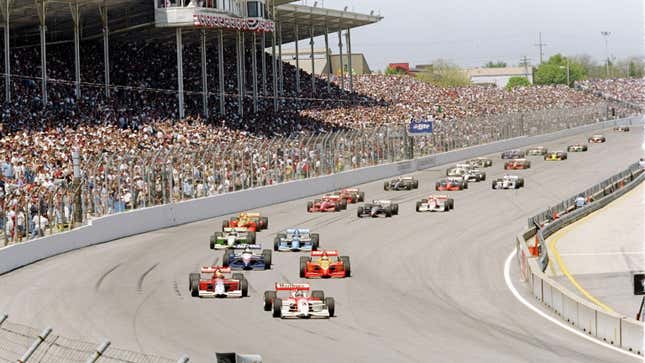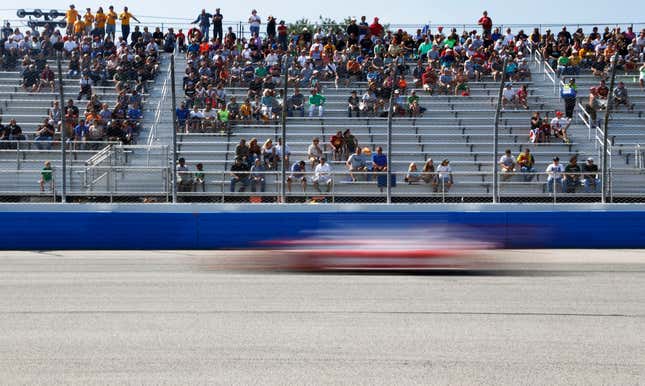Seriously, Why Does Milwaukee Matter To IndyCar?

There’s no time for rest or relaxation after the most prestigious racing event in the U.S.: The Indianapolis 500. In fact, IndyCar drivers, teams and employees are quite used to the quick turnaround from “The Greatest Spectacle in Racing” and a month in Indianapolis to a jam-packed back-to-back weekend of races in Detroit. But before the Motor City landed that next-up calendar date, it once belonged to Milwaukee.
Listen To The Lexus RC F Sing Through The California Mountains
Better known to race fans as the Milwaukee Mile — the oval is considered one of the oldest operating tracks in the country. It was built as a private horse racing venue in the 1870s and then purchased by the Agricultural Society of the State of Wisconsin in 1891 to serve as the site of the Wisconsin State Fair.
The IndyCar Series most recently raced at the Milwaukee Mile in 2015, and die-hard fans have been clamoring for a comeback ever since. The Milwaukee Journal Sentinel reported there isn’t a specific plan for a return, but IndyCar confirmed there was a possibility for a revival. IndyCar CEO Mark Miles told the newspaper. “No, there’s a great history there, and people aren’t forgetting that.”
Horseless carriages would first race at the Milwaukee Mile in 1903 and the first IndyCar race was held there in 1911 (and was won by Ralph DePalma). However, it wouldn’t become a championship round until 1939. By the end of the following decade, the event would reach its most fondly remembered form.
Rex Mays sitting in his car during 1937 Vanderbilt CupPhoto: Bettmann (Getty Images)
The Milwaukee Mile began hosting the post-Indy 500 round in 1947, and the race gained its long-standing name in 1950, the Rex Mays Classic. The event was named two-time champion Rex Mays after he was killed in 1949 during a race at the Del Mar Fairgrounds in California. Mays was thrown from his car after swerving to avoid a crashed car, and then he was hit by another car while lying on the racing surface.
Mays won pole position for the Indianapolis 500 four times but was never a winner. The Californian became a local hero in Milwaukee anyway. He won at the mile oval three times in 1939, 1941 and 1946, bookending the suspension of motorsport caused by World War II. Despite his successes at the Milwaukee Mile, Mays was revered for an act of selflessness at the track. In 1948, Mays crashed out of the post-Indy 500 race avoiding driver Duke Dismore lying on the track after a separate incident. He climbed out of his car, ran across the active oval and pulled Dismore to safety, saving his life.

A packed house for the 1997 Miller 200Photo: Jed Jacobsohn (Getty Images)
Later, the sport’s biggest names, like Andretti, Foyt and Unser, entertained raucous Dairy State crowds. Emerson Fittipaldi was actually booed during driver introductions in 1993 after he sipped orange juice in victory lane at the Indianapolis 500 the week prior. Passionate fans fueled the event as much as the close action on-track.
For various reasons, the Milwaukee Mile struggled to draw fans in the late 2000s leading to the track promoter filing for bankruptcy in 2010. The race was later revived in 2011 by Michael Andretti, with the after-Indy date now occupied by the Detroit Grand Prix. The Milwaukee race survived for five more years before leaving the schedule again.

Plenty of room in the grandstands during the 2014 ABC Supply Wisconsin 250Photo: Tom Lynn (Getty Images)
Things looked bleak for the Milwaukee Mile over the past decade, with no racing there after 2015 until hosting an ARCA stock car date in 2021. There were fears that the oval could have been demolished during the long hiatus. With IndyCar’s popularity rebounding and Wisconsin investing $3 million in the Milwaukee Mile, there’s the chance of yet another race revival.
The fans will determine if it’s a success or not. NBC commentator and former IndyCar driver said it best on his podcast, “If you say you want Milwaukee back on the calendar and it comes back on the calendar, get your ass to Milwaukee.” History and tradition can be heartwarming, but spectator events can not be financially sustainable with spectators.



